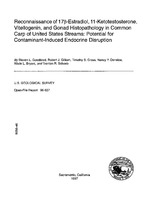A reconnaissance of sex steroid hormones and other biomarkers in common carp was used to assess whether endocrine disruption may be occurring in fish in United States streams, to evaluate relations between endocrine disruption and contaminant levels, and to determine requirements for further studies. 17?-estradiol, 11-ketotestosterone, vitellogenin, and gonadal histopathology were measured in adult carp (usually 10--15 for each sex) at 25 sites (647 fish), representing a wide range of environmental settings typical of major regions of the nation. Fish were collected during August--December 1994, a period of gonadal maturation after spawning. Contaminants evaluated were organochlorine pesticides and polychlorinated biphenyls in tissue; phthalates, phenols, and polycyclic aromatic hydrocarbons in bed sediment; and dissolved pesticides in water. Mean site concentrations of steroid hormones spanned two orders of magnitude for both sexes. No significant regional differences in steroid hormones were detected for males, but females from the Northern and Southern Midcontinent were significantly different from other regions of the country in one or both hormones. Within all regions there were significant differences between sites in one or both hormones for both sexes. Most correlation coefficients between biomarkers and contaminants were negative. Contaminants that had significant (a=0.05) correlations with biomarkers were organochlorine pesticides, phenols, and dissolved pesticides. The strongest pattern common to both males and females was a negative correlation between the hormone ratio (E2/11-KT) and dissolved pesticides. The significant site-to-site differences in biomarkers, and the presence of significant correlations between biomarkers and contaminants, are evidence that fish in some streams may be experiencing endocrine disruption. Improved information is needed to evaluate whether endocrine disruption is actually occurring and if there are reproductive effects on individual or populations of carp or other species. Future studies should shift to more intensive study of fewer sites, including reference and contaminated sites, in order to address these additional questions.


